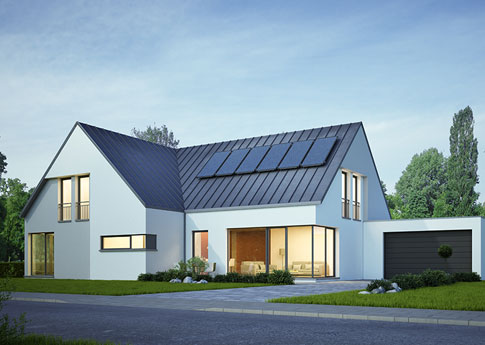Membership and connected space not available
Our membership registration and connected space will not be available December 14, from 8:30 p.m. to 11:30 p.m. because of systems maintenance. We apologize for any inconvenience.
Green building: A guide to sustainable construction

Are you planning to build or renovate your home in a more sustainable way? Green building helps reduce your carbon footprint, improve your home’s energy performance, and better protect the environment. Here’s an overview of the main principles, benefits, and expected costs, along with the financial incentives available to help you bring your sustainable housing project to life.
What is green building?
Also known as sustainable construction or eco-friendly building, green building involves designing and constructing a home, often with recycled materials, to reduce greenhouse gas emissions and our environmental impact, and minimize reliance on fossil fuel.
A green building project should be approached holistically—from the design phase to the operation of the building—taking into account building designs, material selection, and construction methods.
The pros and cons of green building
There are several key benefits to sustainable construction projects:
Reduced environmental impact
Improved energy savings
Better indoor air quality
Eligibility for government rebates and financial assistance programs
The main drawback of an eco-friendly home is its initial cost, as sustainable materials and systems tend to be more expensive than conventional ones.

“However, just like electric vehicles, green homes require a higher upfront investment but result in significant long-term savings—especially on maintenance and utility bills. That’s the essence of green building: focusing on lifecycle costs instead of just the purchase price.”
Julie BoudriasResidential Advisor, CAA-Quebec
Before you start, request a cost estimate to better plan your budget.
So, what are the three core principles of green building?
1. Using eco-friendly materials
An eco-home is built using renewable, durable, minimally processed, and non-toxic materials. Here are a few examples of eco-friendly building materials for your home’s interior:
Bio-based materials: wood, cork, hemp, or cellulose insulation
Solid wood, plywood, or wood paneling for walls
Hardwood, linoleum, or polished concrete for floors
Steel roofing, which is a long-lasting and eco-friendly alternative to asphalt shingles
Recycled cellulose insulation, made from newspaper—low-cost and very effective
Sustainable construction also promotes buying locally sourced materials and reusing building components whenever possible.
Tip: Building on a concrete slab—without a basement—reduces both the amount of concrete used and overall construction costs.
To qualify as a green home, your house should blend seamlessly with its surroundings. Factors such as the building’s orientation, landscape, nearby vegetation, and local climate must all be considered. Of course, everything must comply with the Quebec Construction Code.
2. Maximizing energy efficiency
Orient most windows to the south to take advantage of passive solar heating and maximize natural light. Good to know: This can reduce heating costs by 15% to 20%.
Install overhangs and design your landscaping to prevent overheating in summer. Good to know: An extended roof overhang above the most windowed wall can block up to 90% of summer sunlight.
Choose triple-glazed windows.
Insulate your building envelope beyond Quebec’s building code standards.
Install a high-efficiency wall-mounted heat pump instead of electric baseboards. Tip: Use your heat pump year-round and reserve electric heating for extremely cold days.
Install solar power panels to generate renewable electricity. Tip: Plan for solar panels during construction, even if you install them later.
Did you know?
A Novoclimat-certified home can help you save up to 20% on energy costs.
To qualify for financial assistance, your project must:
Be registered before construction begins
Be residential in nature
Be located in Quebec
Use electricity or residual forest biomass as its main energy source
Involve new construction
3. Managing water responsibly
Water conservation is one of the key principles of sustainable building. To achieve it:
Choose dual-flush toilets
Install low-flow fixtures such as faucets and showerheads
Good to know: WaterSense-certified products can help you save 20% to 30% more water.
Need help reducing your water and electricity consumption?
If you’re a CAA-Quebec member, our Residential Advisory Services can answer all your questions. Get personalized advice on energy-efficient home upgrades like water heaters, low-consumption appliances, and other eco-friendly equipment.
Financial assistance and green home grants
There are several ways to reduce the cost of building a green home:
Government incentive programs (provincial and federal), such as Novoclimat or Rénoclimat, for building or renovating eco-friendly homes.
Cashback offers and rebates from financial institutions.
Municipal programs offering property tax breaks for LEED-certified homes.
Check the updated list of financial aid and green home grants on our website.
Special thanks to the Écohabitation team for their contribution to this article.

Benefit from personalized advice
Do you have questions about your home, need specific information, or are you looking for referrals to find an Approved Supplier?
